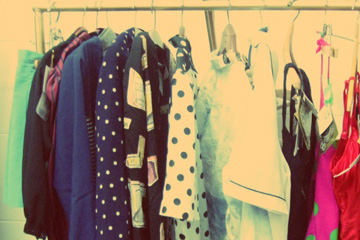31 de agosto de 2012
Ecology in Grandmother’s Closet
Por Fernanda Morales Estudiante de la Facultad de Comunicación Social -Periodismo
Since 2005 Vintage trend has been imposed in fashion around the entire world. 
The rescue of old clothes became trend in runways and streets, not only with the aim of recover the aesthetics of the past, the vintage style is also an option to recycle and transform existing clothes and stop the pollution caused by the textile industry. Nowadays, the concept of vintage is distorted. The idea is not that the clothes look old, the goal is to be really antique. This means that clothing are not manufactured. There are treasures that are recycled and transformed for at least 20 years, bringing stories preventing the manufacture of new textiles whose production process is one of the most polluting, because for the production of textiles is necessary to use large amounts of chemicals and reagents that affect the quality of air and water of places that the industry use from empty waste
The textile industry has a big pollution problem. The World Bank estimates that 17 to 20 percent of industrial water pollution comes from textile dyeing and treatment. They have also identified 72 toxic chemicals in our water solely from textile dyeing, thirty of which are cannot be removed.
 In response to the new challenges for conservation of environment and considering that fashion is cyclical, that mean that trends repeat themselves, preserve and transform old clothes according to the season is too a money saving alternative to buyers. In Europe and the U.S. buying used clothing is an accepted activity, while in Colombia it has been synonymous with poverty for a long time. “Times are changed and people are opening the mind, persons appreciate and value the old fashion, and Colombians is understanding the logic of fashion world and the worrying state of water and environment. Vintage is back to fashion past and the world, back to days when we could breathe clean air and drink clean water, always dressed very chic “says Mónica Millán designer and clothing restorer.
In response to the new challenges for conservation of environment and considering that fashion is cyclical, that mean that trends repeat themselves, preserve and transform old clothes according to the season is too a money saving alternative to buyers. In Europe and the U.S. buying used clothing is an accepted activity, while in Colombia it has been synonymous with poverty for a long time. “Times are changed and people are opening the mind, persons appreciate and value the old fashion, and Colombians is understanding the logic of fashion world and the worrying state of water and environment. Vintage is back to fashion past and the world, back to days when we could breathe clean air and drink clean water, always dressed very chic “says Mónica Millán designer and clothing restorer.
 Laura Chavarro, who designs accessories with recycled materials and is the owner of the brand Bling Bling Trash (see pictures) , says than is very hard to go against capitalism, which forces us to buy and produce an exaggerated, however, reuse and exchange things can meet that cultural need “Everybody can have more options in the closet always, if you use creativity, you can transform clothing and accessories according to the trends. The problem is that people want to discardeverything, if is unfashionable is trash because is difficult be different in a world to equal people”
Laura Chavarro, who designs accessories with recycled materials and is the owner of the brand Bling Bling Trash (see pictures) , says than is very hard to go against capitalism, which forces us to buy and produce an exaggerated, however, reuse and exchange things can meet that cultural need “Everybody can have more options in the closet always, if you use creativity, you can transform clothing and accessories according to the trends. The problem is that people want to discardeverything, if is unfashionable is trash because is difficult be different in a world to equal people”
Currently in Bogotá there are about ten stores dedicated to collecting, selling and trading vintage clothes. Almost all function as e-commerce, in addition to their commitment to the environment. Electronic stores reduced by 40% CO2 emissions compared to traditional stores. Electronic commerce on average consumes 30% less power, reduces fuel costs of its customers by 40% and prevents wastage of paper bills, according to the Federation of Electronic Commerce and Distance Selling. “We provide options for your fashion needs and budget by giving value to what you already own as we Promote a lifestyle of reinvention and love for the environment and our communities” say Nicolas Achury and Kika Perez, owners of The Bogota Vintage Company whose slogan is , recycle, reuse, recreate.
Definitely the old fashion trends in the streets are only what we see. Behind is a major initiative to give a respite to the planet. Nature pays a high cost for our tastes in fashion. It is time to change habits and find solutions. For now looking for what to wear in the grandmother’s closet seems be a good choice.

